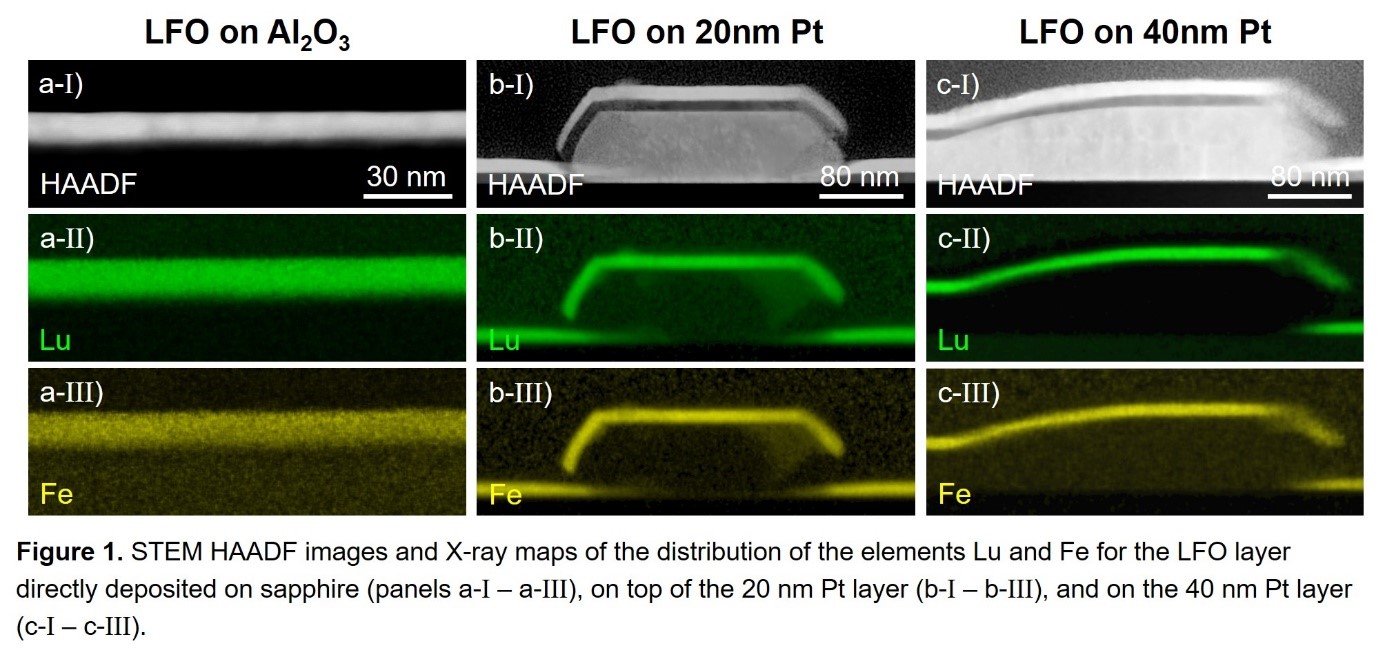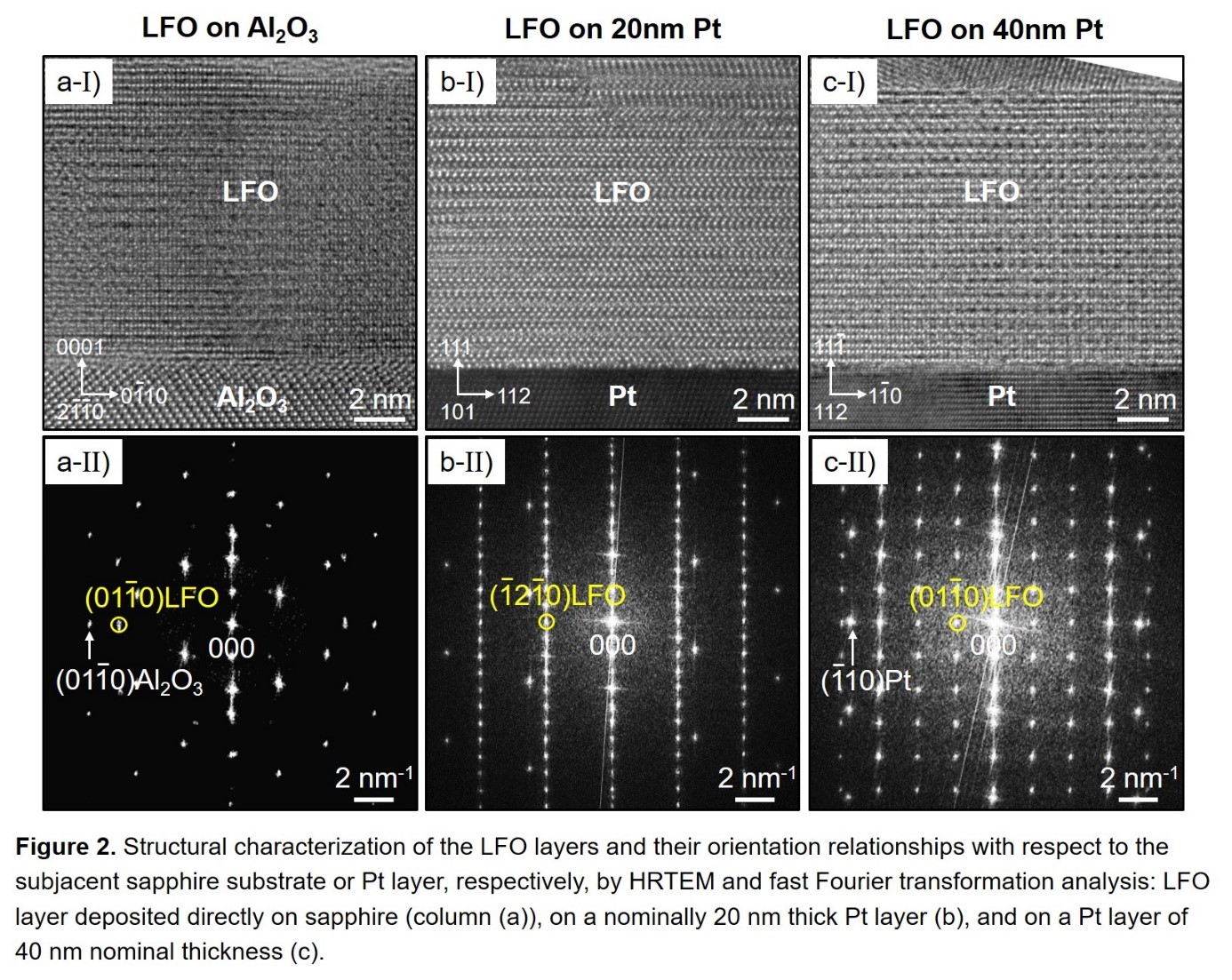Multiferroelectrica
Ferrites of rare earth metals with hexagonal crystal structure in form of h-RFeO3 (R = Y, Dy-Lu) are promising candidates for many future applications in information processing and storage due to their multiferroic properties [1].
In this work, the structure and microchemistry of thin LuFeO3 (LFO) layers produced by pulsed laser deposition (PLD) were studied by transmission electron microscopy (TEM), including high-resolution TEM (HRTEM) as well as scanning TEM (STEM) combined with energy-dispersive X-ray spectroscopy (EDXS). The crystal quality of LFO was investigated in dependence on the growth parameters and the substrate of either sapphire or a PLD-grown Pt layer. These studies aimed to find suited experimental conditions for epitaxial growth of high-quality h-LFO on different substrates.
LFO films were deposited on Pt layers with nominal thicknesses of 20 nm and 40 nm on top of Al2O3 (0001) or directly on this substrate by PLD via a Nd:YAG laser at a repetition rate of 5 Hz. Cross-section TEM lamellas were prepared from these samples by focused-ion-beam milling using an FEI dual beam Helios G4 FX microscope. For TEM investigations, a 200 kV FEI Tecnai Osiris and a 300 kV FEI Titan 80-300 transmission electron microscope was used, where the latter has a Cs image corrector. Combined STEM/EDXS analyses were performed on the Osiris microscope with an FEI Super-X detector.
Typical STEM HAADF images and X-ray maps of Lu and Fe of the three different samples are depicted in Fig. 1. In the sample with the bare LFO (Figs. 1a-I – 1a-III), the layer thickness appears to be homogeneous, which is ~10 nm. For the sample with 20 nm thick Pt (Figs. 1b-I – 1b-III), no continuous Pt layer is present but rather island-like structures. The Pt islands have the shape of truncated pyramids with heights in the range between 70 nm and 100 nm. Evidently, in regions without Pt islands there is no Pt interlayer between LFO and Al2O3. An incomplete Pt interlayer is also observable in the sample with nominal 40 nm thick Pt, however, because of the thicker Pt layer, the islands’ height is likewise much larger (~145 nm to 220 nm). In addition, there are also regions with layer-on-layer growth of LFO on Pt. For each sample, the hexagonal crystal structure of LFO was proved by HRTEM imaging (Fig. 2). However, there are clear differences in the crystalline quality of the individual LFO layers, which can be attributed to the particular subjacent material, i.e. sapphire or Pt. For LFO on sapphire, the layer shows a partly strongly disturbed crystal structure, in particular many stacking faults, owing to the high misfit of 29% between the lattices of h-Al2O3 and h-LFO. For h-LFO grown on Pt, there is a good epitaxial relationship of the two crystal lattices due to the less misfit of ~6%. Digital image analysis revealed that, in the out-of-plane direction, there is an epitaxial match of the (0001) lattice planes of LFO and the (111) Pt planes. In in-plane direction, there is, e.g., 1210 h-LFO || 112 Pt (Fig. 2b) or 0110 h-LFO || 110 Pt (Fig. 2c).
The results clearly demonstrate that the crystalline quality of the LFO layers on Pt is better than on sapphire, and moreover, it seems to improve with increasing thickness of the Pt interlayer.


References
[1] H. Schmid, Ferroelectrics 162 (1994) 317.
[2] S. Bauer et al., Materials 13 (2020) 61.
[3] The support of Czech Science Foundation (project 19-10799J) and German Research Foundation (projects SCHN 669/11 and BA 1642/8-1) is acknowledged.
Selected conference poster presentations:
Analytical TEM study of thin PLD-grown LuFeO3 layers on Pt/sapphire substrates (pdf)
